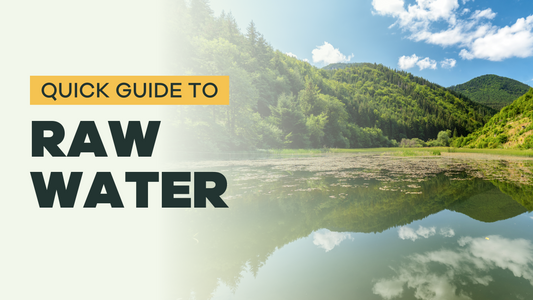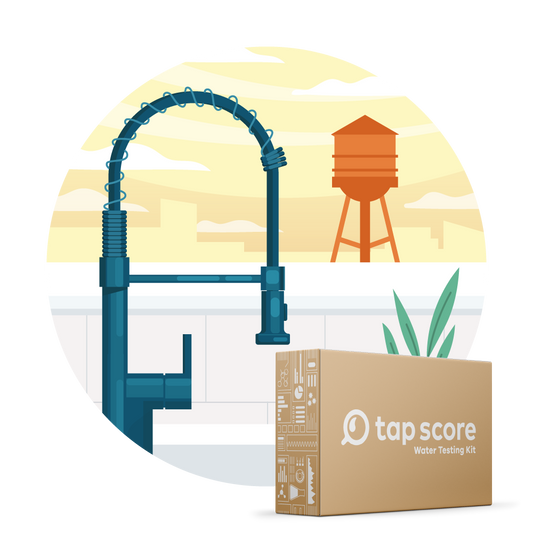
Shock Chlorination: Quick Guide to Disinfecting Your Well Water
Our blog is written by real experts— not AI. Each guide is carefully reviewed and updated based on the latest research. Plus, with no affiliate links, you can count on unbiased insights you can trust.
If you ever wanted to know how to purify well water for drinking, look no further. Shock chlorination is a relatively convenient way to disinfect your well and well water lines.
This guide to shock chlorination gives you a clear method for treating your drinking water to kill coliform, E. coli, and other potentially harmful bacteria living in your water supply.
Table of Contents:
- What Is Shock Chlorination?
- When Should You Shock Chlorinate Your Well?
- How Does Shock Chlorination Work?
- Shock Chlorination Advisory
- Pre-Chlorination Checklist
- Well Water Disinfection Instructions
Key Takeaways:
- Shock chlorination is an affordable way to address contamination from coliform bacteria in well water. While it can be done yourself, we do recommend having a professional perform the service.
- It is important to take safety precautions when shocking your well and to have a separate source of water during the disinfection process.
- Tap Score’s Well Water Test Kits can help you determine if your well has a bacteria problem and confirm the effectiveness of shock chlorination.
What Is Shock Chlorination?
Shock chlorination is a method of disinfecting well water that involves adding a specific concentration of chlorine to inactivate harmful bacteria, viruses, and other pathogens. After treatment, the water system is thoroughly flushed to remove any residual chlorine and contaminants. If you suspect bacterial contamination of your well, some symptoms of bacteria in well water include:
- Changes in water color, odor, or taste
- Acute illness (vomiting, diarrhea, upset stomach, etc.) in those who drink the water
- Cloudiness or a film or sheen on the water's surface
If you notice any of the above, you should cease consumption and test your well water for coliform bacteria right away.
When Should You Use Shock Chlorination for Your Well?
Shock chlorination can be used when you detect bacteria in your pipes and well system. However, chlorinating your system will not work if the source of your bacteria is your groundwater; bacteria will quickly repopulate your well and distribution system.
If the source of the bacteria is your groundwater itself, there might be a nearby source of contamination. Some potential sources of groundwater contamination include:
- A septic tank leak
- Damaged equipment allowing surface contaminants to enter your well directly
- A natural disaster such as a flood or hurricane that has impacted the area’s groundwater
- A wastewater spill into surface or groundwater sources
In these cases, we recommend you address the source of contamination immediately.
You may also need to employ a different method for routinely controlling bacteria in your water. Rather than a “shock” treatment, we recommend a continuous disinfection system, like UV disinfection or a continuous chlorine-drip. (The Top 4 Home Water Filter Technologies Explained)
If you’ve tested your well water and have detected microbial contamination, then shock chlorination may be a viable solution for you and your home. It's worth noting, while it can be done yourself, we recommended shock chlorination be performed by a professional to ensure safety and effectiveness.
How Does Shock Chlorination Work?
Chlorine kills bacteria and other microorganisms by oxidizing biomolecules, like proteins and nucleic acids. This works well for certain microbial organisms, but there are others that are resistant to chlorine disinfection.

Pathogens Readily Killed by Chlorine:
- E. coli
- Coliform bacteria
- Most iron, manganese, and sulfur bacteria
- Salmonella
- Legionella
- Klebsiella
- Vibrio cholerae (which causes cholera)
- Campylobacter
- Certain Staphylococcus species
- Certain Giardia species
- Most viruses
Pathogens Resistant to Chlorine:
- Cryptosporidium
- Giardia
Will Shock Chlorination Work for My Well?
That depends. Our instructions should work for most drinking water wells, but it’s possible that your well or water system has components that aren’t accounted for in our guide.
Shock Chlorination Advisory: Don’t Drink the Water!
The shock chlorination method involves adding a very high concentration of chlorine to your water system. It is important to take safety considerations into account. Here are some very important things to read through and understand before performing shock chlorination on your water.
Do NOT drink (or use) the water during the disinfection process.
During the disinfection process, NO water from the system is safe to drink or use in any manner. Humans or animals should NOT be in contact with the water until the water system has been flushed—which requires at least 12 hours after beginning the process in order to give the chlorine time to disinfect the water. If possible, toilets or faucets should not be used during this time.
Pre-Shock Chlorination Checklist:

💧 Plan to Use Other Sources of Water
Plan ahead. You should have an alternate source of water available for up to 24 hours after you plan to perform shock chlorination on your well.
💧 Turn Off Sprinklers and Other Automated Water Features
Shock chlorination is most effective when your chlorine mixture reaches all ends of your water system. You want the chlorine to come in contact with as many potentially contaminated surfaces as possible—nozzles, spigots, tanks, hoses and fixtures alike.
However, you want to bypass equipment that is sensitive to chlorine and be sure that any systems that you don’t want chlorine to reach—especially sprinklers and other automated water features—are set to the OFF position during your chlorine shock. You don’t want highly chlorinated water spraying all over your lawn!
💧 Disconnect or Bypass Any Water Treatment Systems
If you have a water treatment system installed in your home, you’ll want to temporarily disconnect or bypass it during the period of shock chlorination.
The high level of chlorine used in shock chlorination can permanently damage sensitive water treatment equipment, including reverse osmosis membranes, and exhaust carbon filters. You can contact the company that installed your home water treatment system or reference the owner's manual for more information about whether or not you’ll need to bypass your system and how to do so if necessary.
💧 Don’t Touch
Do not allow chlorine bleach to come into direct skin contact. We suggest wearing rubber gloves, goggles, and a chemical-resistant apron when handling your disinfection materials.
If you accidentally come into contact with chlorine, flush the affected area with clean water (i.e., your alternate water source for the post-chlorination phase) immediately.
💧 Plan Ahead for the Safe Disposal of Chlorinated Flush Water
After shock chlorination is complete, do not dispose of the chlorinated flush water near any livestock or plants. You’ll want to flush this highly chlorinated water in a safe way, like into the ground in an area with no grass or plants and away from sensitive areas like septic systems, storm drains, and surface water.
Do NOT dispose of this water into any natural bodies of water as it will harm aquatic life. Plan accordingly.
💧 Purchase Supplies
- Water test: To confirm you have coliform bacteria like E. coli or other microbial contamination in your well. We recommend our Coliform Enumeration Water Test Kit.
- Liquid household bleach: Must have at least 5% chlorine for disinfection to work properly. Do not use bleach with any additives like fragrance or scent. As a rule of thumb, one gallon of bleach can disinfect an 8-inch diameter well holding approximately 100 feet of water.
- Bottled drinking water: You’ll want enough of a supply of backup water to last the time your entire water supply will be out of commission and during the initial shutoff, (12-24 hours) and then for the approximately one-week period when drinking the water is not advised (until a test proves the disinfection was effective).
- Large bucket, 10 gallon volume: You’ll use this to mix the bleach with water so that you have more disinfectant solution to work with.
- Garden hose (or equivalent): You’ll use this to wash down your well and circulate your disinfectant.


Well Water Chlorine Shock Disinfection Instructions
-
Locate Your Well
Locate your well, clear the surrounding area of debris, turn the well pump circuit breaker off, and then remove the sanitary seal or access plug.
-
Calculate the amount of chlorine
Use the table below to determine how much chlorine bleach you will need for disinfection. If you have a recent Water Well Bore Report, you can refer to it to find the depth of your well and the water level. Otherwise, you can use this table to estimate the amount of chlorine bleach you will need

-
Preparing your chlorine bleach
With the right amount of chlorine bleach for your well measured out, mix it with some water so that you have a greater volume of disinfecting solution to work with. Having more volume will help to ensure your disinfectant is properly distributed across the various well and water system surfaces.

To this end, we advise that you prepare 4 to 8 gallons of the chlorine bleach and water mixture in your 10 gallon bucket.
-
Pour your mixture into the well

Pour the chlorine-water mixture around the sides of your well casing. If the 10 gallon bucket is too difficult to lift, use smaller buckets to scoop the mixture from your big bucket and pour it into the well (make sure you’re wearing gloves!) Try to pour the liquid in a circular motion to promote as much mixing as possible.
-
Circulate the disinfecting chlorine in a hose loop
First, you'll want to turn you well pump back on, reactivating your water supply. Now that the chlorine is in the well, it is time to circulate it around so that the whole well gets disinfected:
- Connect one end of a hose to a nearby spigot that draws from your well.
- Drop the other end of this hose down your well casing.
- Turn on the water at the spigot.
You’ve just created a circular loop—well water goes from the well to your spigot, through the hose, and back into the well.

After 15 minutes of circulating the well water, you should smell a rather strong chlorine odor. Once you notice the smell, you can turn off the spigot and remove the hose.
-
Run your disinfectant solution throughout your system
First, be sure that you have disconnected or bypassed water filters and other chlorine-sensitive equipment throughout the house.

To run disinfectant through your system:
- Go to every faucet around the house, one by one, and run your water until you can smell chlorine coming out of the faucet. As soon as you are sure that the chlorine disinfectant is coming out of the faucet, you can turn it off and head to the next one.
- Go to every toilet around the house and flush it.
- Go to your water heater tank and drain it, let it refill with the chlorine shocked water.
If at any point while you are running faucets you are unable to detect the smell of chlorine, go back to the well and add an additional half gallon of chlorine bleach to 10 gallons of water and repeat Step 4.
- Let it be
Once you’ve run your disinfectant chlorine solution to every faucet in the house (and confirmed the smell of chlorine), you are ready for the long wait. We suggest letting the chlorine stand in your pipes and well for at least 8 hours. 12-24 hours is preferable.
During this time, make sure that nobody uses any of the water in your house for anything. It will be dangerous to drink and harmful to your skin. Make sure you have an alternate water source for people and animals.
Be sure to turn off automatic sprinklers because high chlorine concentrations are not good for your plants. - Flush it out
After allowing the chlorine mixture to sit in the system for 12-24 hours, it is time to fully flush it out.
Head outside and run water from any available spigot, preferably one with a hose. Dispose of this water away from any plants. Do not drain this water into your septic system.
Keep the water running until you no longer smell any chlorine. This may take twenty minutes or more. You should also flush all of the faucets around the house for a few minutes until they no longer smell of chlorine. Once the chlorine is flushed from your system, you can reconnect any chlorine-sensitive equipment you turned off during treatment. -
Test your water to make sure the treatment worked!
After one week we suggest you perform another bacterial water test to confirm that your chlorine shock treatment has been successful. You should avoid drinking your water until you are sure the treatment worked.
After two months we suggest running one more test to make sure your water has not been recontaminated. If you find re-contamination, there may be another cause for bacterial contamination.







